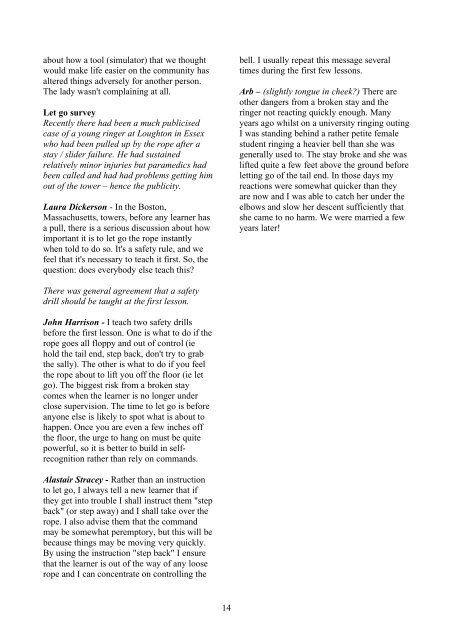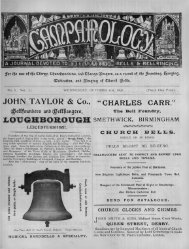The Central Council of Church Bell Ringers Education Committee
The Central Council of Church Bell Ringers Education Committee
The Central Council of Church Bell Ringers Education Committee
You also want an ePaper? Increase the reach of your titles
YUMPU automatically turns print PDFs into web optimized ePapers that Google loves.
about how a tool (simulator) that we thought<br />
would make life easier on the community has<br />
altered things adversely for another person.<br />
<strong>The</strong> lady wasn't complaining at all.<br />
Let go survey<br />
Recently there had been a much publicised<br />
case <strong>of</strong> a young ringer at Loughton in Essex<br />
who had been pulled up by the rope after a<br />
stay / slider failure. He had sustained<br />
relatively minor injuries but paramedics had<br />
been called and had had problems getting him<br />
out <strong>of</strong> the tower – hence the publicity.<br />
Laura Dickerson - In the Boston,<br />
Massachusetts, towers, before any learner has<br />
a pull, there is a serious discussion about how<br />
important it is to let go the rope instantly<br />
when told to do so. It's a safety rule, and we<br />
feel that it's necessary to teach it first. So, the<br />
question: does everybody else teach this?<br />
<strong>The</strong>re was general agreement that a safety<br />
drill should be taught at the first lesson.<br />
John Harrison - I teach two safety drills<br />
before the first lesson. One is what to do if the<br />
rope goes all floppy and out <strong>of</strong> control (ie<br />
hold the tail end, step back, don't try to grab<br />
the sally). <strong>The</strong> other is what to do if you feel<br />
the rope about to lift you <strong>of</strong>f the floor (ie let<br />
go). <strong>The</strong> biggest risk from a broken stay<br />
comes when the learner is no longer under<br />
close supervision. <strong>The</strong> time to let go is before<br />
anyone else is likely to spot what is about to<br />
happen. Once you are even a few inches <strong>of</strong>f<br />
the floor, the urge to hang on must be quite<br />
powerful, so it is better to build in selfrecognition<br />
rather than rely on commands.<br />
Alastair Stracey - Rather than an instruction<br />
to let go, I always tell a new learner that if<br />
they get into trouble I shall instruct them "step<br />
back" (or step away) and I shall take over the<br />
rope. I also advise them that the command<br />
may be somewhat peremptory, but this will be<br />
because things may be moving very quickly.<br />
By using the instruction "step back" I ensure<br />
that the learner is out <strong>of</strong> the way <strong>of</strong> any loose<br />
rope and I can concentrate on controlling the<br />
14<br />
bell. I usually repeat this message several<br />
times during the first few lessons.<br />
Arb – (slightly tongue in cheek?) <strong>The</strong>re are<br />
other dangers from a broken stay and the<br />
ringer not reacting quickly enough. Many<br />
years ago whilst on a university ringing outing<br />
I was standing behind a rather petite female<br />
student ringing a heavier bell than she was<br />
generally used to. <strong>The</strong> stay broke and she was<br />
lifted quite a few feet above the ground before<br />
letting go <strong>of</strong> the tail end. In those days my<br />
reactions were somewhat quicker than they<br />
are now and I was able to catch her under the<br />
elbows and slow her descent sufficiently that<br />
she came to no harm. We were married a few<br />
years later!









